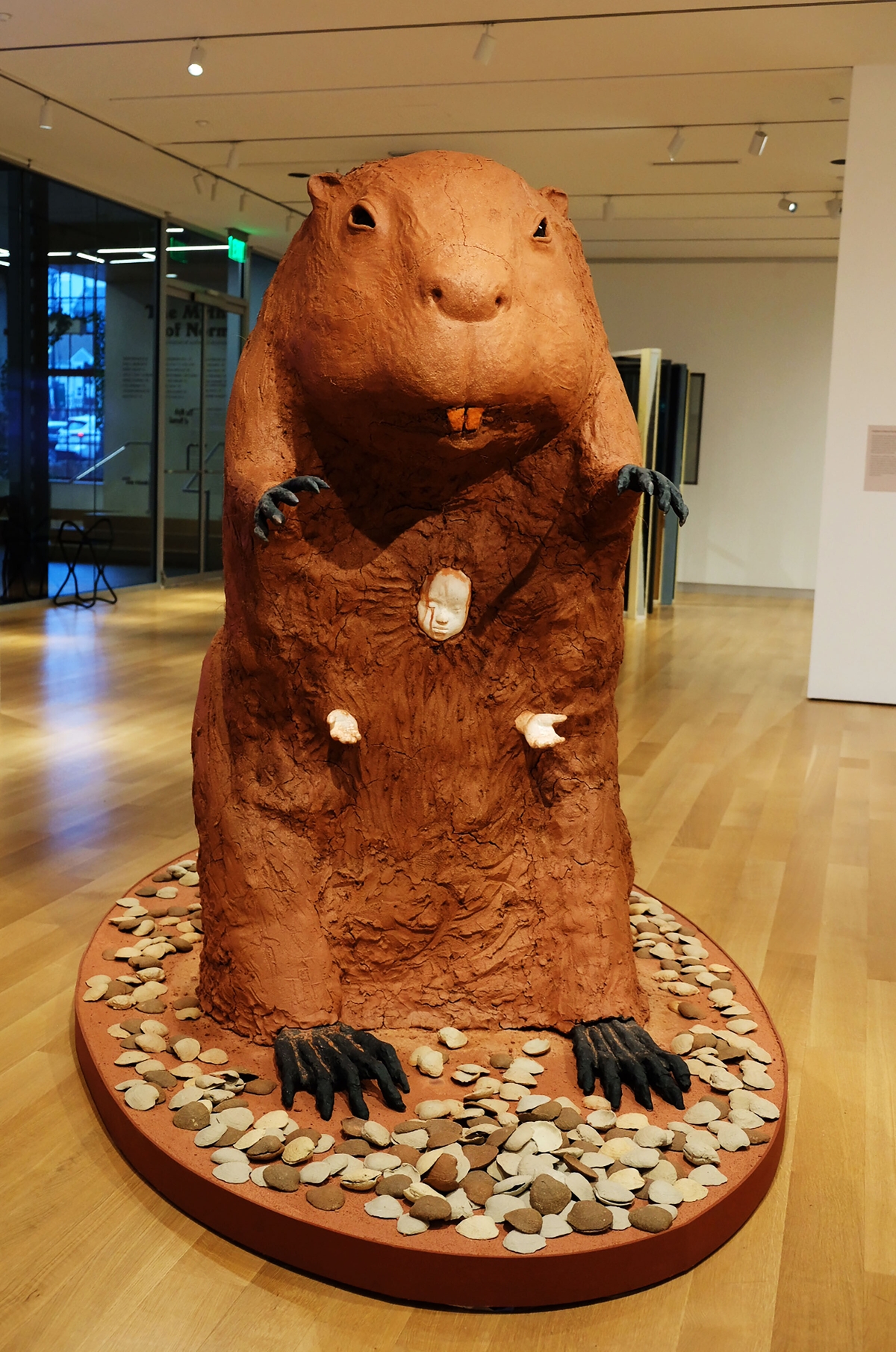Boston
Post-“Normal” World Glimpsed
by | Dec 21, 2023 10:22 am
Post a Comment | E-mail the Author
Posted to: Visual Art

Sasha Patkin Photo
“Gluskabe Comes Home" by Richard Steitmatter-Tran.
The Myth of Normal: A Celebration of Authentic Expression
MassArt Art Museum
621 Huntington Ave.
Through May 19, 2024
Sitting in the middle of a gallery at MassArt Art Museum is a giant beaver. Ripping out of its belly in horror-movie fashion is what seems to be an infant.
The effect is disorientating, strange, and perhaps a little morbidly comical. It’s weird, and that may be the point.
Curated by Mari Spirito ‘92, The Myth of Normal: A Celebration of Authentic Expression, on display at the MassArt Museum until May 2024, features the work of 30 alumni to celebrate the 150th anniversary of the Massachusetts College of Art and Design and makes you rethink the way you see the world.
The beaver is a piece by Richard Steitmatter-Tran ’03, “Gluskabe Comes Home.” It represents Gluskabe, a figure in Native American legends known for bringing survival knowledge and moral codes to live by and punishing those who break them.
The artist reflects on their adoptive grandfather’s Penobscot tribe’s roots and explains in their artist statement, “emerging from this beaver is the figure of a child which could be his grandfather, father, the artist, or his child, an intergenerational continuum.”
I did wonder briefly if I had stumbled into the typical “art school” exhibit, with vague artist statements and esoteric art. But the longer I stayed in the gallery the more interesting the exhibition became.
“Normal,” of course, is a broad theme. The exhibition takes specific inspiration from the book The Myth of Normal: Trauma, Illness, and Healing in a Toxic Culture, by Gabor Maté MD and Daniel Maté. Copies of this book were placed throughout the gallery. While the book is over 500 pages, an accompanying gallery guide explains its focus on an examination of unhealthy norms, beliefs, and behaviors (such as overworking) which are typically considered normal even though they are making us physically and emotionally sick. The guide explains that the Matés put forward authentic expression as a force to combat these unhealthy behaviors, and Spirito extends this line of thinking to propose art as a form of self-expression and pivotal to wellness.

Sasha Patkin Photo
Detail of Chanda Méndrez-Ortiz's "Parks Entrance, 2023."
The Myth of Normal exhibition stretches from the exterior to the lobby and through two gallery spaces. There are too many pieces displayed to talk about in a single review, but the galleries are loosely curated into themes.
The first grouping of art explores architecture as an extension of the body, using buildings as metaphors for structural constraints and thoughts of freedom and containment. Of this grouping, I was particularly drawn to Chanda Méndrez-Ortiz ’05’s homage to Gordan Park’s 1956 photograph “Department Store, Mobile Alabama.” Méndrez-Ortiz uses found photographs of magazines and personal archives to offer layered narratives and uses scarring to symbolize trauma manifesting in a collective psyche.
The second section, of which “Gluskabe Comes Home” was a part, focuses on personal stories and untold histories. There were a variety of mediums here. On the wall were several screens, I caught Ezra Wube ‘04’s “Una Favola Vera (A True Fairytale), which uses stop motion animation of political propaganda to tell the history of the Italian invasion of Ethiopia during World War Two; and Luther Price ’87’s “Kittens Grow Up, 2007,” which uses found footage of a working-class family in crisis in combination with footage of kittens, reflecting on stress that impedes brain development.

Sasha Patkin Photo
The upper level of the museum.
The upper level of the museum explores how painful experiences can be transformed into innovation and looks toward the future. Art from Jack Pierson ’86 takes the prompt of authentic expression literally, repurposing the abandoned signage from marquees and diners into a giant sign which reads, “Are you fucking shitting me?” It seems to serve as a caption for the entire upstairs gallery and its tongue-in-check refusal of the expected.

Sasha Patkin Photo
Works by Mimi Smith
Mimi Smith ’63 reflects on gender biases and unpaid home/childcare laborers. “Steel Wool Camisole” combines lingerie and steel wool for scrubbing pots and pan. “Recycle Coats” is made out of wrapping from household items, which she says simultaneously protects and defines its wearer. “Nonpulets” features nine plastic babies in the coat, which Smith notes is a critique of the normalization of hyper-competitive approaches to the production of everything, including human life.
The upper gallery is huge and open and bright with a high ceiling — and serves as a perfect host for the fresh note of optimism that the third grouping provides and which often gets lost in academic artistic inquiries. The art in the gallery blooms, reflects, reappropriates discarded materials, and offers new perspectives. Above it all, QR codes by Mark Skwarek ’01 and Joseph Hocking create an augmented reality view of the sky when viewed through an app.
It’s a large exhibit that tries to cover a lot under its broad theme. After all, isn’t self-expression the point of most art? Through immersive sculptures, hair, comics, videos, photographs, collages, CDs lining the floral, murals, and LED lights, the exhibition ties together the diverse experiences of generations of MassArt alummi into a purposeful community, seemingly offering hope for another world where the norms are a little less normal.